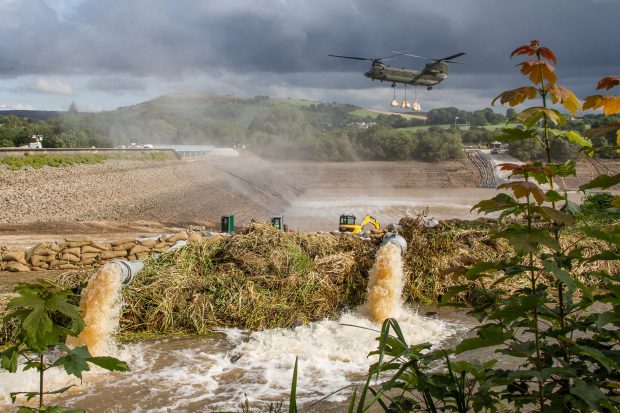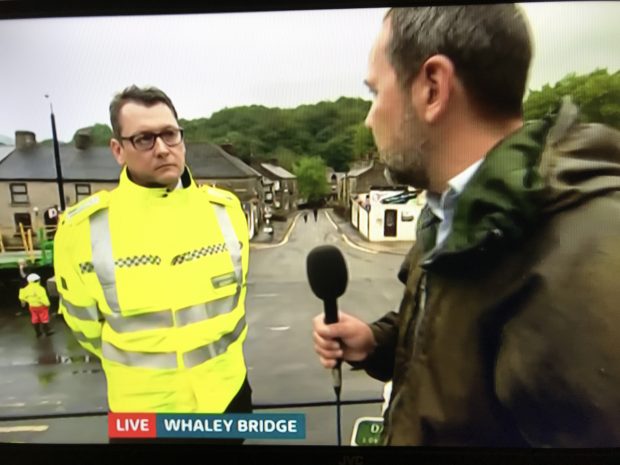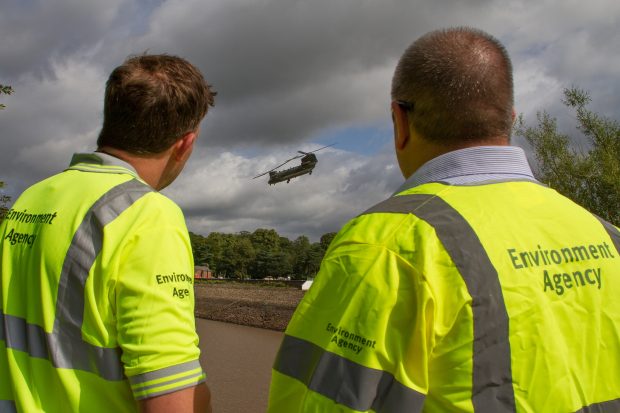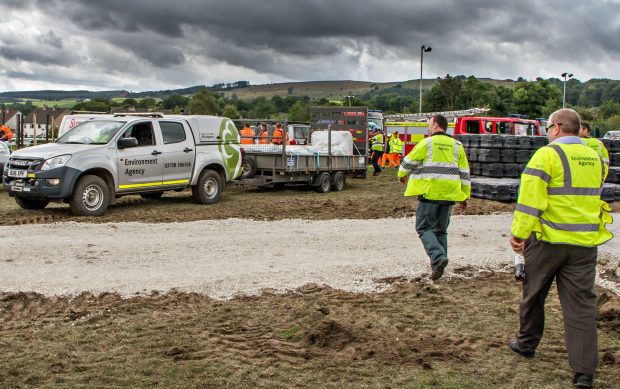
Lee Rawlinson, Area Director for Greater Manchester, Merseyside and Cheshire
Three weeks on from unusually heavy rain and flooding was seen across the North West and Derbyshire, recovery work has started in affected towns and villages including Whaley Bridge. Lee Rawlinson, Area Director for Greater Manchester, Merseyside and Cheshire recalls the events that led to the evacuation of 1,500 people and looks at the aftermath.
A defining image of Whaley Bridge was looking out over the Toddbrook Reservoir to a ghost town below. An RAF Chinook helicopter had been drafted in to try and shore up the dam but despite the sounds of the whirring blades and the noise of the multi-agency response on the ground, the sun shone and there was an unnatural sense of calm. For several days starting from the 28th July, unusually heavy rain had fallen on the North West. Then, on 1st August, we got the call that a dam in Whaley Bridge, Toddbrook Reservoir, was deemed unsafe.
Suddenly, an Environment Agency flood warning that had been in place was upgraded to severe meaning that there was a significant danger to life. The residents of Whaley Bridge were evacuated and our major incident plan kicked into action.
We immediately formed a multi-agency response and deployed Environment Agency pumps and specialist officers to the site. In the midst of it all, I found myself on the ground and became the go to media spokesperson in those first vital hours.
“'We are preparing for the worst, but hoping for the best" - Lee Rawlinson speaking with ITV at Whaley Bridge on August 1st.

In the following hours and days, Environment Agency teams on the ground and in the Greater Manchester, Merseyside and Cheshire Incident Room worked 24/7 alongside our partners in Derbyshire Police, Fire and Rescue service and the Canal and Rivers Trust in an effort to reduce water levels in the reservoir.
Soon afterwards, military aid arrived along with an RAF Chinook helicopter. Using a pilot precision that was almost beyond comprehension, the dam wall was packed with 530 tonnes of aggregate and cemented into place to reinforce the structural integrity of the spillway.
Those images of the helicopter circling above our EA staff with their prominent yellow jackets are the ones that stand out the most. In its re-telling through pictures, the nature of the Whaley Bridge incident became almost film like.

After days of pumping hundreds of thousands of litres of water, coordinating on-site maintenance activity and reassuring residents that we, and our partners, were doing all we could to get them back into their homes, the news that we had all been waiting for came through. The water within Toddbrook Reservoir had been reduced to a safe level and the community could finally return.
However, as with many incidents the Environment Agency face, this news was something of a double-edged sword. While we were elated that levels within the reservoir were pronounced safe for human life, it was not completely the case for wildlife. Namely the many fish that called the reservoir home.
As a result, another evacuation began to take place and the fish were netted and successfully moved to a safer Canal and Rivers Trust location within the West Midlands.
As with everything in this incident, the end was just as fast-paced as the start. On 6th August, the severe flood warning was scaled back to an alert and 50 properties were allowed to return with the remainder being allowed back by August 8th.
The positivity and thanks received from the Whaley Bridge community was nothing short of heart-warming. Messages were posted around the village expressing complete gratitude to the teams who ‘saved Whaley Bridge.’ Pub landlords invited the response unit in for a free drink and once the community was back in action, members of the public kept our teams on site fully fed and watered.
Looking back, it is the reaction of the residents that truly make our incident response a very real and significant thing. Floods have the power to devastate lives and in this instance, we got to save them.
I am so proud of #TeamEA and our partners at Derbyshire Police, Derbyshire Fire and Rescue and The Canal and Rivers Trust for the part they played in the Whaley Bridge Incident. It has been a real team effort!
The work is not over yet though. In the aftermath of the floods across the North West and Derbyshire, our Community Information Officers poured into towns including Poynton, Handforth, Bollington Mill and Whaley Bridge offering information and advice as well as signposting people to help and advice. Even now, across the North West, EA staff are still protecting properties by undertaking grid runs, operating pumps and maintaining public safety by ensuring rivers remain clear.
In Whaley Bridge, we have been working alongside the Canal and River Trust to monitor water levels of Toddbrook reservoir and supporting the community out on the ground. Site meetings have also taken place as part of the multi-agency response with a view to progressing permanent solutions to the repair of the dam.

Last week, our Hydrometry and Telemetry team also installed a third monitor around Toddbrook Reservoir to measure water levels and better inform flood alerts and warnings. The monitors have been placed on the spillway, on the bypass and upstream of the reservoir in order to provide the most accurate data readings.
The term flood resilience is now in common usage and the focus is now on recovery. Our field teams who are carrying out detailed assessments of our assets and rivers across the North West to ensure communities are as protected as they can be from the risk of flooding.
In addition to the clearance operations, our specialist reservoir team have been in touch with the operators of more than 2,000 reservoirs since the Toddbrook incident requesting that all operators check that there are no safety concerns and ensuring there are strong on-site reservoir emergency plans in place. Once we are confident that the short term measures for flood recovery have been addressed and resolved, we will start to plan for the longer-term works to boost flood resilience within our communities.
Having been a witness to Storm Desmond and Eva, I continue to ask myself if anything can change the effects of such extreme rainfall and I believe re-thinking the way we manage our flood risk is key.
We are focussing more on whole river catchments, identifying how we can combine hard flood defences with natural methods to slow the flow of water. We are working closer than ever with local communities and partner organisations to build on our knowledge and resources and make flood resilience not just a word but the key word.

Amongst all this we are continuing to invest £2.6 billion across the country up to 2021 to better protect 300,000 homes and thousands of businesses from flooding.
We have also recently consulted on our Flood and Coastal Risk Management Strategy, which looks out to 2100 and sets out how we can work together to make our homes, businesses and infrastructure more resilient to a changing climate.
Looking back on Whaley Bridge demonstrates the importance of keeping our infrastructure prepared whilst also continuing to reduce flood risk to our communities and build their resilience to future adverse weather. This is and always has been the main focus of our work.

2 comments
Comment by Derek Pritchard posted on
The Environment Agency look very nice in their parade uniforms and the RAF/Fire Brigade very active in their battle dress.
Comment by Michael Mann posted on
This is a good story so far. It would be good to hear what is happening to progress and complete repairs that are 'flood resistant', although 'flood proof' would be better for this particular site, or tell us where that information can be found.
How resilient is the Canal and River Trust? Is the cost of this work covered by insurance or government guarantee?
The result we are all seeking is that the reservoir is returned to its former state and the wildlife, fishing, and sailing etc can return, and the residents are not cut off from access to and across the reservoir to conduct their lives.
We are hearing that this will take years to conclude - is that correct?
The consequences for some are significant - there are positive effects, but some people have seen property values drop and this is a direct consequence of the failures of the Canal and Property Trust to follow proper procedures for maintenance and inspections.